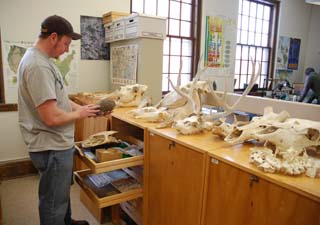Zooarchaeology Laboratory
Zooarchaeology Laboratory

The Zooarchaeology Laboratory is the center for training undergraduate and graduate students in the major methods and techniques used in archaeological faunal analysis. Research and training is designed to prepare students in the analysis of animal remains from archaeological sites, and from these analyses infer past lifeways, paleo-environments, and prehistoric human adaptations. The zooarchaeology laboratory contains an extensive modern comparative skeletal collection of northeastern and southwestern fauna. The lab is equipped with the necessary tools with which to conduct faunal research, including a fume hood, Nikon microscopes, computers and spaced for analyses and storage. Projects currently being conducted in the lab:
- Paleonutrition – analyses of prehistoric diet, health, and nutrition is a constant theme of research conducted in the lab. Currently, we are analyzing bones, botanical remains, pollen, and DNA from southwestern Texas paleofeces to determine ancient diet and diseases, sex differences, and migratory patterns.
- Prehistoric Northeastern Adaptations – analyses of faunal remains from coastal Maine shell midden sites to determine prehistoric animal use as they relate to diet, migratory patterns, and prehistoric land use.
- Zoogeography Project of Maine – analysis of the prehistoric faunal record to map migrations and extinctions of extant and extinct species through time and across space in prehistoric Maine and the maritime Provinces.
- Southwestern Zooarchaeology – analysis of faunal remains from Singuan, Anasazi, and Big Bend, Texas archaeological sites to determine changes in prehistoric land use, diet, and migrations through time.
The Zooarchaeology Lab is directed by Anthropology Staff.
